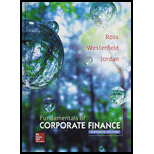
Concept explainers
MIRR [L06] RAK Corp. is evaluating a project with the following cash flows:
| Year | Cash Flow |
| 0 | −$41,000 |
| 1 | 15,700 |
| 2 | 19,400 |
| 3 | 24,300 |
| 4 | 18,100 |
| 5 | −9,400 |
The company uses an interest rate of 10 percent on all of its projects. Calculate the MIRR of the project using all three methods.
To calculate: The MIRR (Modified internal rate of return) for the project utilizing all three methods
Introduction:
MIRR is the Modified internal rate of return, which is a financial measure of attracting the investments. It is utilized in the capital budgeting to rank the alternative investments of same size.
Answer to Problem 19QP
The MIRR for the project using the discounted approach is 22.68%, reinvestment approach is 16.69%, and the combination approach is 15.94%.
Explanation of Solution
Given information:
Company R is assessing a project, where the cash flows are$15,700, $19,400, $24,300, $18,100, and -$9,400 for year 1, 2, 3, 4, and 5 respectively. The initial cost is $41,000.
Discounted approach:
In this approach, compute the negative cash outflows value at the year 0. On the other hand, the positive cash flows remain at its time of occurrence. Hence, discount the cash outflows to year 0.
Hence, the discounted cash flow at time 0 is -$46,836.66.
Equation of MIRR in discounted approach:
Compute MIRR using a spreadsheet:
Step 1:

- Type the equation of NPV in H6 in the spreadsheet and consider the MIRR value as H7.
Step 2:
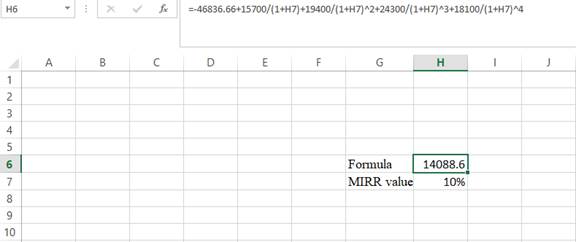
- Assume the MIRRvalue as 10%.
Step 3:
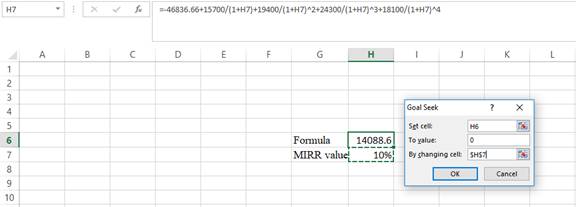
- In the spreadsheet, go to data and select the what-if analysis.
- In what-if analysis, select goal seek.
- In “Set cell”, select H6 (the formulae).
- The “To value” is considered as 0 (the assumption value for NPV).
- The H7 cell is selected for the “By changing cell”.
Step 4:
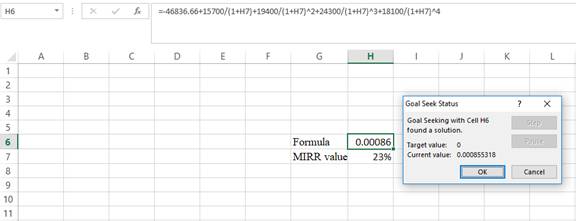
- Following the previous step, click OK in the goal seek. The goal seek status appears with the MIRRvalue.
Step 5:
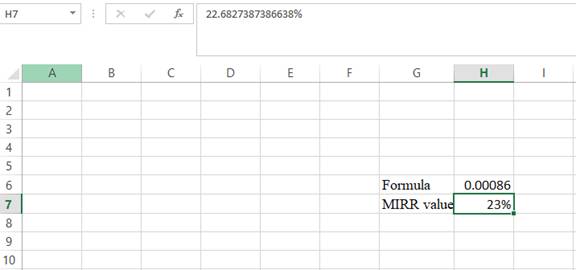
- Thevalue appears to be 22.6827387386638%.
Hence, the MIRRvalue is 22.68%.
Reinvestment approach:
In this approach, compute the future value of all the cash flows excluding the initial cost at the closure of the project. Hence, compute the reinvesting cash flows to year 5 as:
Hence, the reinvesting cash flow at time 5 is $88,720.77.
Equation of MIRR in reinvestment approach:
Compute the MIRR:
Hence, the MIRR is $16.69%.
Combination approach:
In this approach, compute all the cash outflows at year 0 and all the cash inflows at the closure of the project. Hence, the value of the cash flows is as follows:
Hence, the total cash outflow at year 0 is -$46,836.66.
Hence, the value of total cash inflows is $98,120.77.
Equation of MIRR in combination approach:
Compute the MIRR:
Hence, the MIRR is $15.94%.
Want to see more full solutions like this?
Chapter 9 Solutions
Fundamentals of Corporate Finance with Connect Access Card
- What is the 4% rule in retirement planning in finance?arrow_forward(Calculating NPV) Carson Trucking is considering whether to expand its regional service center in Moab, Utah. The expansion will require the expenditure of $10,000,000 on new service equipment and will generate annual net cash inflows from reduced costs of operations equal to $2,500,000 per year for each of the next 8 years. In year 8, the firm will also get back a cash flow equal to the salvage value of the equipment, which is valued at $1 million. Thus, in year 8, the investment cash inflow will total $3,500,000. Calculate the project's NPV using a discount rate of 9 percent. If the discount rate is 9 percent, then the project's NPV is (round your answer to the nearest dollar) Sarrow_forward(Calculating annuity payments) The Aggarwal Corporation needs to save $7 million to retire a(n) $7 million mortgage that matures in 17 years. To retire this mortgage, the company plans to put a fixed amount into an account at the end of each year for 17 years. The Aggarwal Corporation expects to earn 13 percent annually on the money in this account. What equal annual contribution must the firm make to this account to accumulate the $7 million by the end of 17 years? The equal annual contribution Aggarwal must make to this account is (round your answer to the nearest cent) $.arrow_forward
- (Calculating NPV) Big Steve's Swizzle Sticks is considering the purchase of a new plastic stamping machine. This investment will require an initial outlay of $95,000 and will generate net cash inflows of $17,000 per year for 11 years. a. What is the project's NPV using a discount rate of 13 percent? Should the project be accepted? Why or why not? b. What is the project's NPV using a discount rate of 14 percent? Should the project be accepted? Why or why not? c. What is this project's IRR? Should the project be accepted? Why or why not?arrow_forwardThe number of years it will take for $490 to grow to $1,057.86 at 7 percent compounded annually is (type your answer in years, round to one decimal place) years.arrow_forwardThe number of years it will take for $500 to grow to $1,039.50 at 5 percent compounded annually is (type your answer in years, round to one decimal place) years.arrow_forward
- (Round your answer to the nearest cent.) $5,000 invested for 10 years at 10 percent compounded annually will accumulate to $arrow_forwardWhat is the difference between operating leverage and financial leverage in finance? i need coarrow_forwardWhat is the Sharpe ratio and how is it used to evaluate investments? need helparrow_forward
 Essentials Of InvestmentsFinanceISBN:9781260013924Author:Bodie, Zvi, Kane, Alex, MARCUS, Alan J.Publisher:Mcgraw-hill Education,
Essentials Of InvestmentsFinanceISBN:9781260013924Author:Bodie, Zvi, Kane, Alex, MARCUS, Alan J.Publisher:Mcgraw-hill Education,

 Foundations Of FinanceFinanceISBN:9780134897264Author:KEOWN, Arthur J., Martin, John D., PETTY, J. WilliamPublisher:Pearson,
Foundations Of FinanceFinanceISBN:9780134897264Author:KEOWN, Arthur J., Martin, John D., PETTY, J. WilliamPublisher:Pearson, Fundamentals of Financial Management (MindTap Cou...FinanceISBN:9781337395250Author:Eugene F. Brigham, Joel F. HoustonPublisher:Cengage Learning
Fundamentals of Financial Management (MindTap Cou...FinanceISBN:9781337395250Author:Eugene F. Brigham, Joel F. HoustonPublisher:Cengage Learning Corporate Finance (The Mcgraw-hill/Irwin Series i...FinanceISBN:9780077861759Author:Stephen A. Ross Franco Modigliani Professor of Financial Economics Professor, Randolph W Westerfield Robert R. Dockson Deans Chair in Bus. Admin., Jeffrey Jaffe, Bradford D Jordan ProfessorPublisher:McGraw-Hill Education
Corporate Finance (The Mcgraw-hill/Irwin Series i...FinanceISBN:9780077861759Author:Stephen A. Ross Franco Modigliani Professor of Financial Economics Professor, Randolph W Westerfield Robert R. Dockson Deans Chair in Bus. Admin., Jeffrey Jaffe, Bradford D Jordan ProfessorPublisher:McGraw-Hill Education





